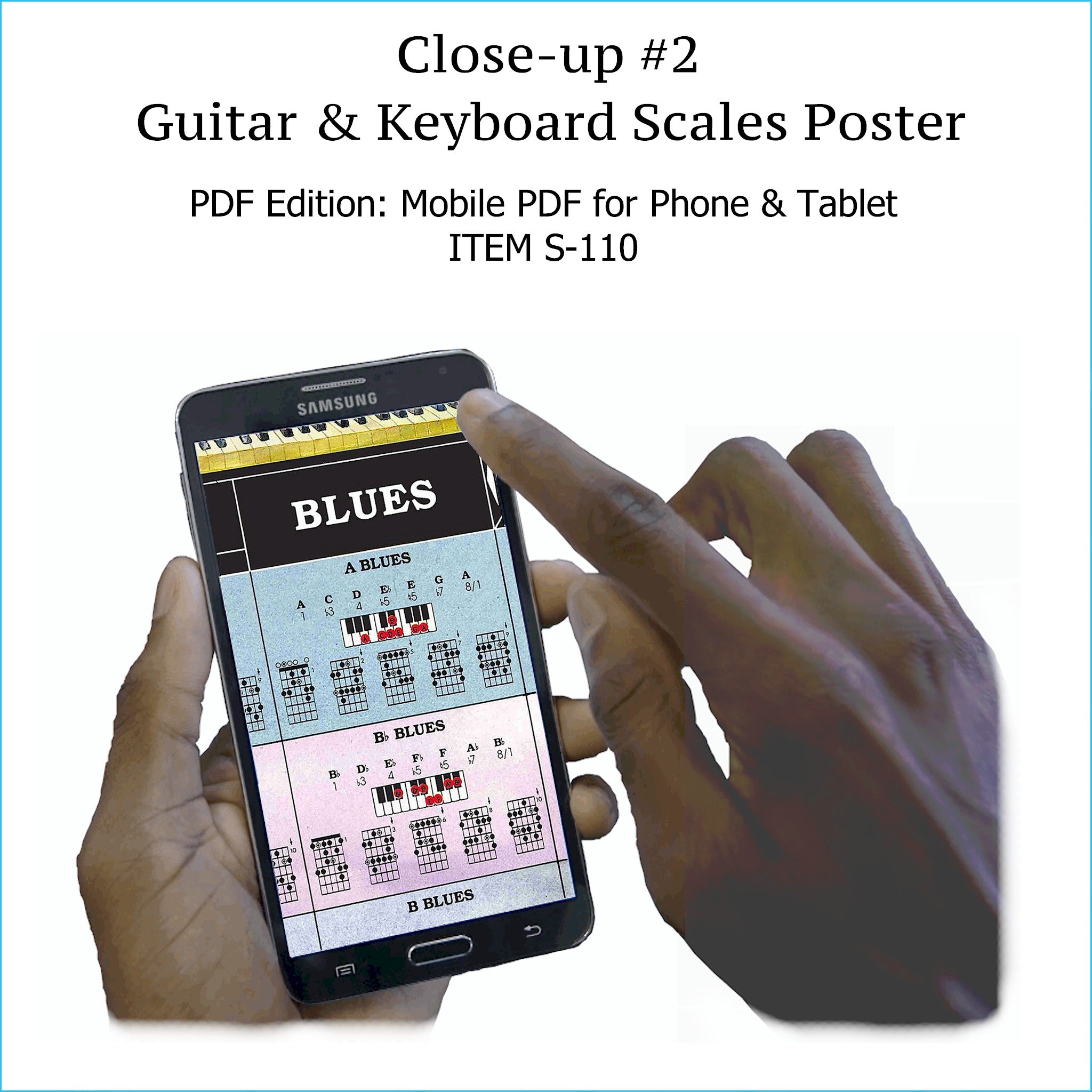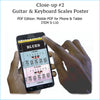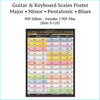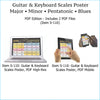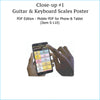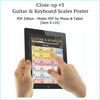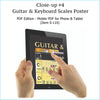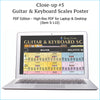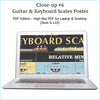Item S-110: Guitar & Keyboard Scales Chart on a SINGLE SCREEN. Zoom In or Out Like a Google Map. High-Resolution PDF. Printable.
- $6.00 $6.00
(Click on DISCOUNTS tab for better pricing.)
See 5 Essential Scale Types in All Major and Minor Keys for Both Guitar and Keyboard at a Glance, on a Single Screen:
NO Searching, Swiping, Tapping, Clicking, or Entering Data
Just zoom in to see any guitar or piano/keyboard scale in detail; zoom out to see the big picture—exactly like a Google map.
About the Guitar & Keyboard Scales Poster, E-Poster Edition
(Also Available as a Laminated Wall Chart, 19" x 27")
Related Scales in the Same Row
Major scales appear in the same row with related minor scales. For example, C Major and C Major Pentatonic scales appear in a yellowish-brown color band. In the same row, to the right, are three related scales in a blue band: A Minor, A Minor Pentatonic, and A Blues. Color-coding by key on the Guitar & Keyboard Scales Poster is the same as it is on the Complete Guitar Chord Poster and the Complete Keyboard Chord Poster.
Because all the scales in any given row are musically related, the scale degrees and scale fingering associated with each scale type within the same row are similar.
Understanding Major and Minor Scales
But what exactly differentiates major scales fromminor scales?
Major scales follow a specific pattern of whole tone (T) and semitone (S): T-T-S-T-T-T-S. This pattern creates the bright, happy sound characteristic of major scales.
Minor scales, on the other hand, follow a different pattern: T-S T-T S-T-T. This produces a sound that is often described as sadder or more somber.
Transforming Major to Minor
To illustrate, let's take the A major scale: A-B-C#-D-E-F#-G#-A. By lowering the 3rd, 6th, and 7th notes each by a half step, we get: A-B-C-D-E-F-G-A. This is the A natural minor scale.
Types of Minor Scales
Unlike the major scale, minor scales come in three varieties:
-
Natural Minor: As shown above, the A natural minor scale is
A-B-C-D-E-F-G-A.
-
Harmonic Minor: By raising the 7th note of the natural minor scale a half step, we obtain the harmonic minor scale. For A minor, this changes G to G#, giving us A-B-C-D-E-F-G#-A.
- Melodic Minor: This scale is formed by raising both the 6th and 7th notes of the natural minor scale. For A minor, this means F becomes F# and G becomes G#, resulting in A-B-C-D-E-F#-G#-A when ascending. Note, however, that when descending, the scale reverts to the natural minor form.
Understanding these patterns can help you navigate and utilize the scales more effectively, whether you're playing the piano or visualizing them on the
Guitar & Keyboard Scales Poster.
How to Read the Scale Diagrams
If you’re unsure of the meaning of any of the numbers and symbols on the Guitar & Keyboard Scales Poster, refer to the example below.
Note that each scale type for each key has either 5 or 7 guitar scale diagrams (depending on the scale type) but only one keyboard scale diagram. That’s because the interval arrangement of strings on a guitar is irregular, unlike the interval arrangement on a piano, which repeats exactly, from octave to octave. On a guitar, the fingering patterns for the same scale type keep changing from octave to octave as you proceed up the fingerboard. So, for any given scale type, several diagrams are needed to show all the fingering patterns at different locations along the fingerboard.
On the guitar scale diagrams, a “bulls-eye” symbol (circle with a dot in the middle) represents the tonic note of the scale. Most of the guitar scale diagrams show a few notes below (leading up to) the lowest tonic note, plus a few notes above (higher than) the highest tonic note.

5 Popular Scale Types
The Guitar & Keyboard Scales Poster displays the following five different popular scale types for both guitar and keyboard:
• Major
• Major Pentatonic
• Minor
• Minor Pentatonic
• Blues
On the left side of the poster, the major scales begin with scales in the key of C Major and continue alphabetically down the chart from row to row (C, C#, D, etc.).
On the right side of the poster, the minor and blues scales begin with scales in the key of A Minor (the relative minor of C Major) and continue alphabetically down the chart (A, B-Flat, B, etc.).
Guitar-Keyboard Crossover Leaning
You can use the Guitar & Keyboard Scales Poster to learn to play the same scales on the keyboard that you play on the guitar, or vice-versa, without having to look up scales elsewhere. Guitar and keyboard scales of the same type are located above/below each other on the poster. Keyboard scale diagrams are located just above the guitar chord diagrams for the same scale type in each key.
For more information on scales and how they work, see Chapters 4 and 5 of How Music REALLY Works!, 2nd Edition, available at www.howmusicreallyworks.com.
Transposing a Scale
Key-specific color bands make it visually easy to transpose a scale from one key to another.
For example, suppose you are starting with the scale D Minor Pentatonic:
D, F, G, A, C, D
And suppose you would like to transpose this scale to the equivalent scale in a different key, such as the scale G Minor Pentatonic. Here’s how:
• You will find the D Minor Pentatonic scale located in the red horizontal bar towards the right side of the poster:
D, F, G, A, C, D
• You will find the G Minor Pentatonic scale located in the grey horizontal bar towards the right side of the poster (near the bottom):
G, B-Flat, C, D, F, G
• Wherever any scale appears in the red bar, just play whichever scale appears in the same column in the grey bar.
Both of these scales, D Minor Pentatonic and G Minor Pentatonic, are located in the same column, the “Minor Pentatonic” column.
Related Charts
The Guitar & Keyboard Scales Poster is related to two other reference charts: the Complete Guitar Chord Poster and its twin, the Complete Keyboard Chord Poster. All three charts match each other in color and layout. All are available at this website.
Product Details
Electronic Poster, High Resolution File Type: PDF File Size: 67 MB Publisher: Roedy Black Publishing ISBN-13: 978-1-897311-33-2ISBN-10: 1-897311-33-8
Electronic Poster, Mobile File Type: PDF File Sizes, Mobile: 2 MB; 5 MB Publisher: Roedy Black Publishing ISBN-13: 978-1-897311-34-9
ISBN-10: 1-897311-34-6
Free Download Protection
All of our e-posters, e-charts, and e-books come with free lifetime download protection. For example, if you forget to back up your files, or if the device hosting your files gets stolen or lost, we will cheerfully replace the files you purchased from us, free of charge.
Get this e-poster at a discount in these bundles:
 B-621: Complete Guitar Chords, Scales - E-Posters and Printable E-Books (6 items)
B-621: Complete Guitar Chords, Scales - E-Posters and Printable E-Books (6 items)
 B-625: Complete Guitar Chords, Scales, Chord Progressions - E-Posters and Printable E-Books (8 items)
B-625: Complete Guitar Chords, Scales, Chord Progressions - E-Posters and Printable E-Books (8 items)
 B-633: How Music REALLY Works! E-Book + Guitar Chords, Chord Progressions, Scales - E-Posters and Printable E-Books (9 items)
B-633: How Music REALLY Works! E-Book + Guitar Chords, Chord Progressions, Scales - E-Posters and Printable E-Books (9 items)
 B-634: Complete Keyboard Chords, Scales - E-Posters and Printable E-Books (6 items)
B-634: Complete Keyboard Chords, Scales - E-Posters and Printable E-Books (6 items)
 B-638: Complete Keyboard Chords, Scales, Chord Progressions - E-Posters and Printable E-Books (8 items)
B-638: Complete Keyboard Chords, Scales, Chord Progressions - E-Posters and Printable E-Books (8 items)
 B-646: How Music REALLY Works! E-Book + Keyboard Chords, Chord Progressions, Scales - E-Posters and Printable E-Books (9 items)
B-646: How Music REALLY Works! E-Book + Keyboard Chords, Chord Progressions, Scales - E-Posters and Printable E-Books (9 items)
 B-657: Complete Guitar Chords, Complete Keyboard Chords, Scales, Chord Progressions - E-Posters and Printable E-Books (11 items)
B-657: Complete Guitar Chords, Complete Keyboard Chords, Scales, Chord Progressions - E-Posters and Printable E-Books (11 items)
 B-665: How Music REALLY Works! E-Book + Complete Guitar Chords, Complete Keyboard Chords, Scales, Chord Progressions - E-Posters and Printable E-Books (12 items)
B-665: How Music REALLY Works! E-Book + Complete Guitar Chords, Complete Keyboard Chords, Scales, Chord Progressions - E-Posters and Printable E-Books (12 items)
 B-836: How Music REALLY Works! Print Book + E-Book, Chord Progressions, E-Posters - Guitar Chords, Scales, Chord Progressions (11 items)
B-836: How Music REALLY Works! Print Book + E-Book, Chord Progressions, E-Posters - Guitar Chords, Scales, Chord Progressions (11 items)
 B-852: How Music REALLY Works! Print Book + E-Book, E-Posters and Printable E-Books - Keyboard Chords, Scales, Chord Progressions (11 items)
B-852: How Music REALLY Works! Print Book + E-Book, E-Posters and Printable E-Books - Keyboard Chords, Scales, Chord Progressions (11 items)
 B-853: How Music REALLY Works! Print Book + E-Book, Laminated Wall Posters, E-Posters and Printable E-Books - Keyboard Chords, Scales, Chord Progressions (17 items)
B-853: How Music REALLY Works! Print Book + E-Book, Laminated Wall Posters, E-Posters and Printable E-Books - Keyboard Chords, Scales, Chord Progressions (17 items)
 B-880: How Music REALLY Works! Print Book + E-Book, Laminated Wall Posters, E-Posters and Printable E-Books - Guitar Chords, Keyboard Chords, Scales, Chord Progressions (21 items)
B-880: How Music REALLY Works! Print Book + E-Book, Laminated Wall Posters, E-Posters and Printable E-Books - Guitar Chords, Keyboard Chords, Scales, Chord Progressions (21 items)
Reviews of the Guitar & Keyboard Scales Poster
What I appreciate having [on the Guitar & Keyboard Scales Poster] is the guitar and piano scales right next to each other. This has made it a breeze to teach my band members new arrangements ... So I can go to the piano and pick out the same melodies I used to know only on guitar, and have a pretty good idea of what I'm doing on the piano, even though I'm a guitar player.
—Dan Eldridge, Ottawa, ON
My wife bought me the Guitar and Keyboard Scales Poster, and now I can't stay away from it for long. It got me out of a rut in my guitar playing, and I'm moving over to try out [playing scales] on her piano.
—Jack Lazic, Chicago, IL
As a bass player, I have found this chart [Guitar & Keyboard Scales Poster] very helpful.
—Henry Priddle, Jacksonville, Fl
How scales are associated and connected, that's what I've always wondered. With the Guitar and Keyboard Scales Poster, it's making sense at last.
—D. Redman, Port Hope, ON

